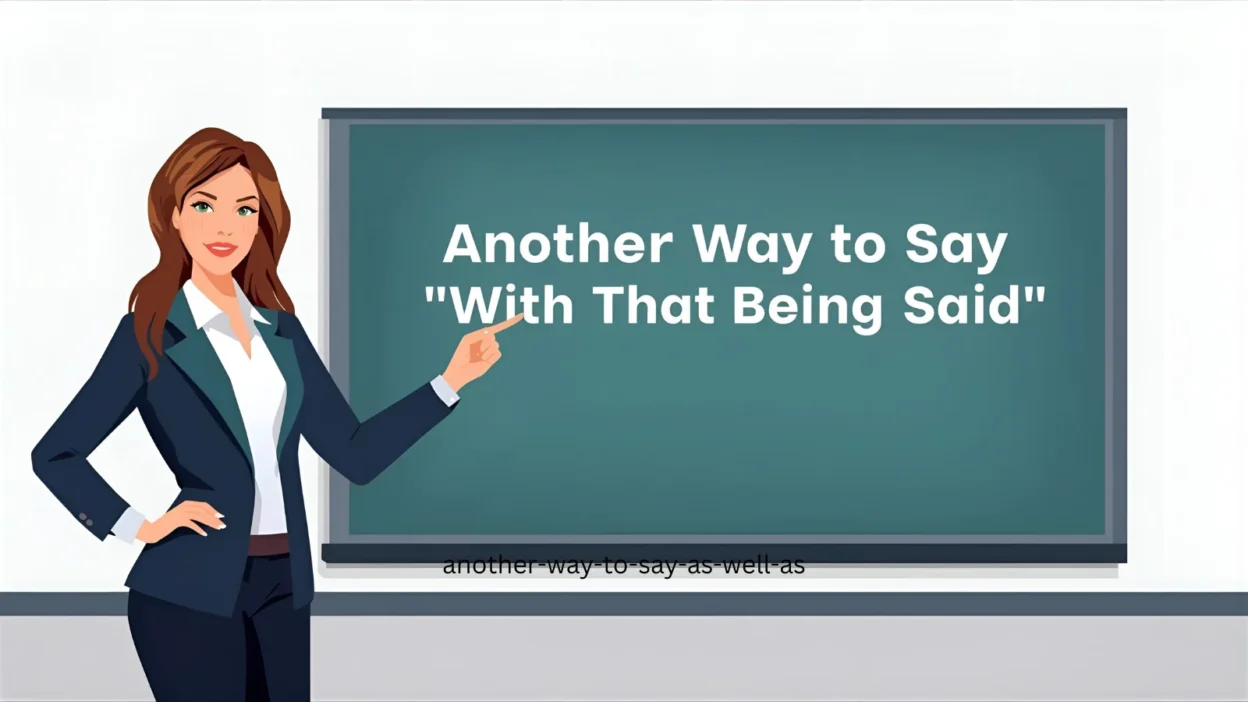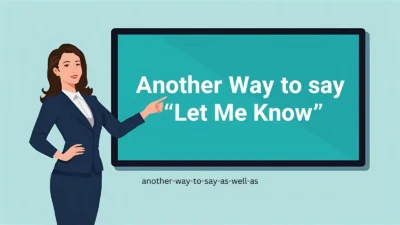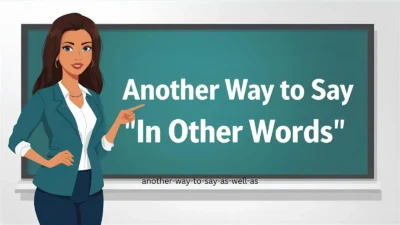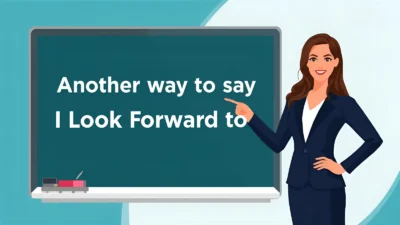The phrase “with that being said” is a popular transition used to shift from one idea to another, often to introduce a contrast, conclusion, or clarification. While it’s effective, using it too frequently can make your writing or speech feel repetitive. Luckily, there are many alternatives that vary in tone—some more formal, some more casual—that can strengthen your communication.
In this article, you’ll discover 50 smart alternatives to “with that being said,” each with meaning, explanation, examples, best use, and tone descriptions.
1. That Said
Meaning: A shorter, smoother version of “with that being said.”
Explanation: Works well in both speech and writing.
Example: “The plan is risky. That said, it might also bring huge rewards.”
Best Use: General writing, casual to formal.
Tone: Neutral, polished.
2. Having Said That
Meaning: Similar to “with that being said,” but slightly more conversational.
Explanation: Adds a reflective or balancing touch.
Example: “It’s a great offer. Having said that, I’m still hesitant.”
Best Use: Informal discussions, essays.
Tone: Conversational, thoughtful.
3. Nevertheless
Meaning: Used to contrast a previous idea.
Explanation: Formal and concise alternative.
Example: “The data is incomplete; nevertheless, we can see a clear trend.”
Best Use: Academic writing, professional reports.
Tone: Formal, strong.
4. Nonetheless
Meaning: Indicates contrast, like “nevertheless.”
Explanation: Slightly softer in tone.
Example: “It was a tough year; nonetheless, the team stayed motivated.”
Best Use: Formal, analytical writing.
Tone: Formal, balanced.
5. Even So
Meaning: Shows that something remains true despite the previous statement.
Explanation: Slightly conversational but still professional.
Example: “The task was difficult; even so, she succeeded.”
Best Use: Writing, presentations.
Tone: Neutral, accessible.
6. Still
Meaning: A concise transition showing contrast.
Explanation: Simple but effective for speech and casual writing.
Example: “It might rain. Still, we should go hiking.”
Best Use: Casual writing, everyday conversation.
Tone: Informal, conversational.
7. Yet
Meaning: Indicates a contradiction or surprising continuation.
Explanation: Works well in short sentences for emphasis.
Example: “He was exhausted, yet he kept working.”
Best Use: Narrative writing, casual to formal.
Tone: Neutral, versatile.
8. But Still
Meaning: A casual way to add contrast.
Explanation: Emphasizes persistence despite a challenge.
Example: “I don’t like spicy food, but still, I tried the curry.”
Best Use: Informal writing, conversation.
Tone: Relaxed, conversational.
9. Be That As It May
Meaning: A formal way to acknowledge something but move on.
Explanation: More traditional and literary.
Example: “He lacked experience. Be that as it may, he was hired.”
Best Use: Formal speeches, essays.
Tone: Old-fashioned, formal.
10. Even Though
Meaning: Acknowledges a contrast between ideas.
Explanation: Simple and widely used.
Example: “Even though it was late, they continued working.”
Best Use: General writing, speech.
Tone: Neutral.
11. All the Same
Meaning: Used to highlight persistence or contradiction.
Explanation: Slightly informal, often in conversation.
Example: “He was tired. All the same, he finished the task.”
Best Use: Informal writing, casual speech.
Tone: Conversational, polite.
12. At the Same Time
Meaning: Balances two points or perspectives.
Explanation: Suggests coexistence of ideas.
Example: “The plan is ambitious. At the same time, it’s achievable.”
Best Use: Presentations, essays.
Tone: Neutral, thoughtful.
13. On the Other Hand
Meaning: Introduces a contrast or alternative.
Explanation: A common transition phrase.
Example: “He enjoys city life. On the other hand, she prefers the countryside.”
Best Use: Formal and informal contexts.
Tone: Balanced, analytical.
14. That Being the Case
Meaning: Accepts the first statement and introduces a result.
Explanation: Slightly formal but clear.
Example: “The evidence is limited. That being the case, we can’t conclude yet.”
Best Use: Formal writing, professional reports.
Tone: Formal, logical.
15. With This in Mind
Meaning: Transition that shows awareness of prior information.
Explanation: Ideal for leading into a conclusion or advice.
Example: “With this in mind, we adjusted our strategy.”
Best Use: Essays, instructions.
Tone: Formal, instructional.
16. Taking That Into Account
Meaning: Considers previous information before proceeding.
Explanation: Emphasizes thoughtful transition.
Example: “Taking that into account, we decided to delay the launch.”
Best Use: Business writing, formal reports.
Tone: Formal, careful.
17. Even Then
Meaning: Shows persistence despite prior conditions.
Explanation: Adds emphasis to contrast.
Example: “She warned him not to go. Even then, he insisted.”
Best Use: Stories, casual writing.
Tone: Neutral, conversational.
18. On the Contrary
Meaning: Highlights an opposite or contradicting point.
Explanation: Stronger than “with that being said.”
Example: “Many think it’s easy. On the contrary, it’s quite challenging.”
Best Use: Arguments, persuasive writing.
Tone: Assertive, formal.
19. But
Meaning: Simple conjunction showing contrast.
Explanation: The most common and straightforward alternative.
Example: “It was late, but he kept working.”
Best Use: Everyday writing and speech.
Tone: Neutral.
20. Even After That
Meaning: Stresses continuation despite previous statement.
Explanation: Useful for storytelling.
Example: “He was discouraged. Even after that, he didn’t give up.”
Best Use: Narratives, casual writing.
Tone: Neutral.
21. All Things Considered
Meaning: Weighing all factors before moving on.
Explanation: A reflective transition.
Example: “All things considered, the project was a success.”
Best Use: Essays, reports.
Tone: Neutral, reflective.
22. In Any Case
Meaning: Regardless of what was just said.
Explanation: Moves discussion forward.
Example: “In any case, we should prepare for the next step.”
Best Use: Semi-formal, everyday writing.
Tone: Neutral.
23. Regardless
Meaning: Indicates contrast or dismissal of previous point.
Explanation: A single-word alternative to show persistence.
Example: “Regardless, we’ll continue with the plan.”
Best Use: Business, general writing.
Tone: Direct, assertive.
24. Despite That
Meaning: Highlights contradiction.
Explanation: Concise and flexible.
Example: “The forecast was bad. Despite that, the event went well.”
Best Use: Formal and casual.
Tone: Neutral.
25. Anyway
Meaning: Informal way to move on or contrast.
Explanation: Works best in casual speech.
Example: “It was raining; anyway, we still had fun.”
Best Use: Conversations, casual writing.
Tone: Informal, relaxed.
Conclusion
The phrase “with that being said” is useful, but it doesn’t have to be your only option. Depending on the tone you want—formal (“nevertheless”), conversational (“that said”), or casual (“anyway”)—you can choose from a wide variety of alternatives. By switching up your transitions, you’ll keep your communication clear, polished, and engaging.



